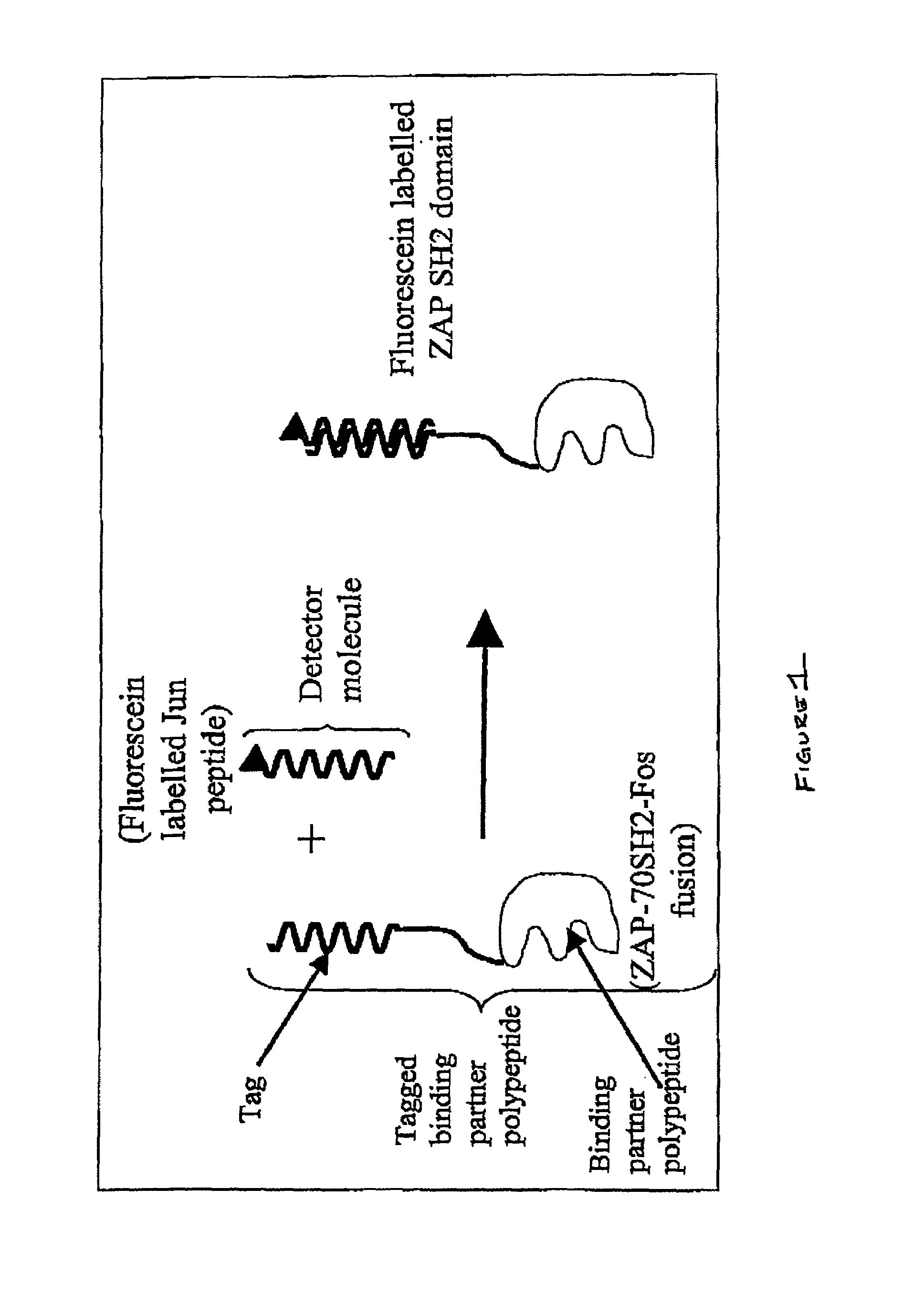Compositions and methods for monitoring the modification of modification dependent binding partner polypeptides
a technology of enzymatic modification and binding partner, which is applied in the direction of material testing goods, biochemistry apparatus and processes, instruments, etc., can solve the problems of limited course, strategy limitations, and disease state, and achieve the effect of facilitating the reduction of non-specific or background proteolysis
- Summary
- Abstract
- Description
- Claims
- Application Information
AI Technical Summary
Benefits of technology
Problems solved by technology
Method used
Image
Examples
example 1
Measurement of Src Protein Kinase and Yersinia Phosphatase Activities by the Modulation of FRET Between Binding Partners Labeled with Fluorescent Coiled-coil Heterodimers
[0266]This example is based on the concept of using heterodimeric peptides as tools to enable specific fluorescent labeling of protein domains. The example describes the use of coiled-coil heterodimers to attach fluorescent labels to protein domains in such a way that binding of the proteins to each other results in FRET between the fluorophores. See FIG. 1.
[0267]The binding partner domains in this example are the SH2 domain of ZAP70 kinase and the zeta chain of the T-cell receptor peptide. The SH2 domain of ZAP70 and the T-cell receptor Zeta chain peptide are able to bind together when the T-cell receptor is phosphorylated by Src or Fyn kinase. This example illustrates the attachment of chemical fluorophores to these binding partners using coiled-coil heterodimers.
DNA Constructs
a) ZAP70-FJ Peptide
[0268]The ZAP70SH2...
example 2
Measurement of Src Protein Kinase and Yersinia Phosphatase Activity using an Immobilized Assay using Binding Partners Labeled with Fluorescent Coiled-coil Heterodimers
[0289]The interaction of the natural binding domains can also be followed if the partner modified by the enzyme is immobilized on a suitable surface, (e.g. through a biotin:avidin interaction or a His-Tag:Ni / NTA interaction). The assay can then be adapted to an endpoint assay format where excess incoming binding partner can be washed away. The assay requires that only one of the interacting partners be labeled with a fluorophore, the other labeled with a suitable anchoring moiety. The assay can be used to determine inhibitors of the binding interaction or of the phosphatase / kinase involved in mediating the interaction.
Immobilized Tyrosine Phosphatase Assay
[0290]A phosphorylated peptide mimicking the critical structure of the TCRζ chain can be biotinylated and bound to a commercially available microtitre plate pre-coate...
example 3
Measurement of Src Protein Kinase and Yersinia Phosphatase Activity by the Modulation of FRET between Binding Partners Labeled with Fluorescent Proteins
[0295]In order to monitor the association of modification dependent binding proteins using FRET or FP, the fluorescent labels must be in the correct location and orientation. One method of adding fluorescent labels to a predictable site on the protein, and controlling their distance and orientation is through the use of proteinaceous fluorophores such as green fluorescent protein, GFP. GFP and mutants of this protein fluoresce at a variety of different wavelengths, and pairs of fluorescent proteins suitable for FRET can be used.
[0296]Modification dependant binding partner polypeptides can be labeled by cloning them into bacterial expression vectors and expressing them as fusion proteins with GFP or a GFP mutant. The following example describes the use of GFP and blue fluorescent protein (BFP) to label modification dependant binding p...
PUM
| Property | Measurement | Unit |
|---|---|---|
| Fraction | aaaaa | aaaaa |
| Length | aaaaa | aaaaa |
| Length | aaaaa | aaaaa |
Abstract
Description
Claims
Application Information
 Login to View More
Login to View More - R&D
- Intellectual Property
- Life Sciences
- Materials
- Tech Scout
- Unparalleled Data Quality
- Higher Quality Content
- 60% Fewer Hallucinations
Browse by: Latest US Patents, China's latest patents, Technical Efficacy Thesaurus, Application Domain, Technology Topic, Popular Technical Reports.
© 2025 PatSnap. All rights reserved.Legal|Privacy policy|Modern Slavery Act Transparency Statement|Sitemap|About US| Contact US: help@patsnap.com



